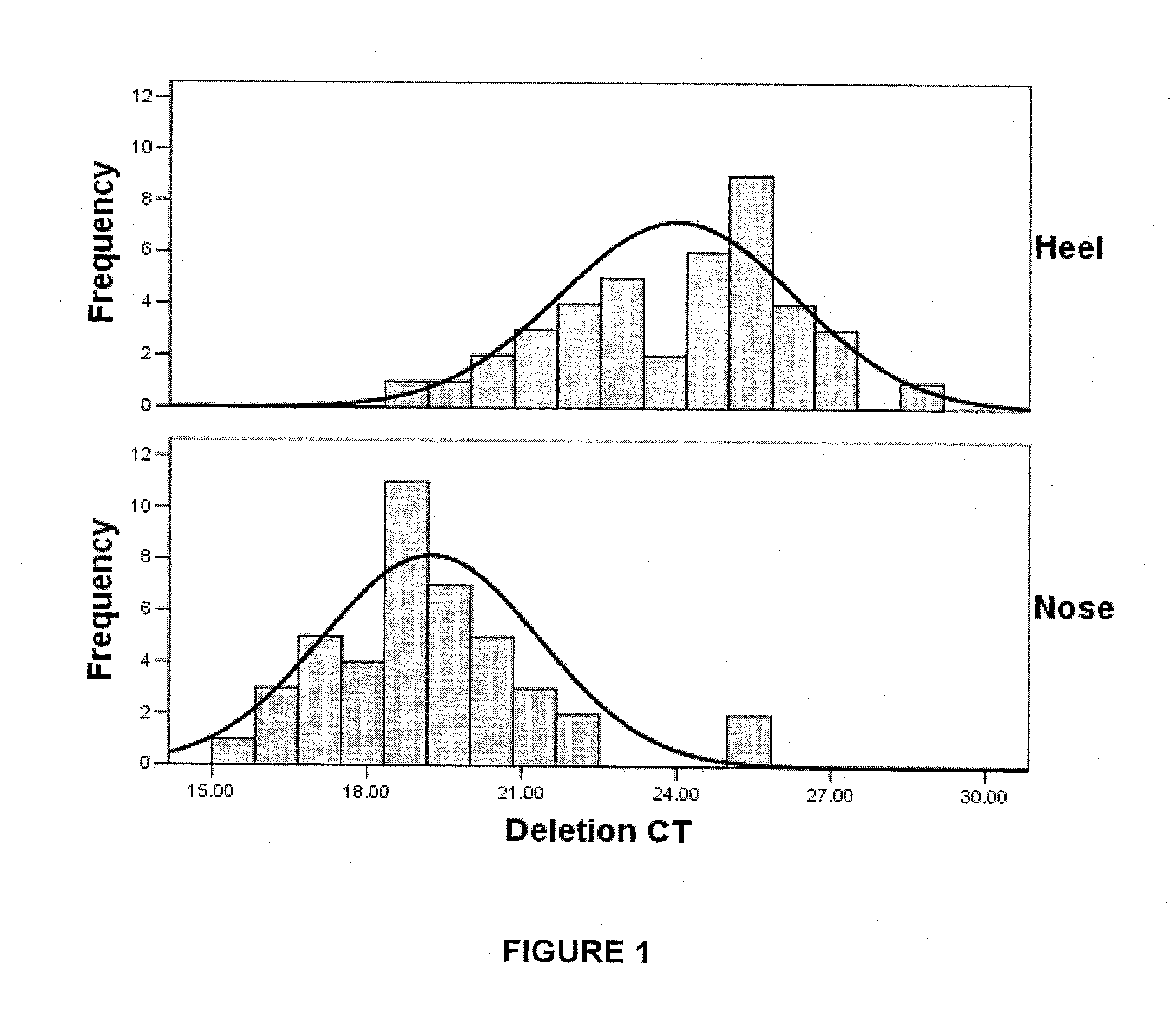Methods for assaying MC1r variants and mitochondrial markers in skin samples
a technology of mitochondrial markers and variants, which is applied in the field of methods for predicting, diagnosing and monitoring skin states and skin diseases, can solve the problems of increasing the chances of infection, not necessarily effective detection methods based on visible observations, and not providing an enriched sample of cells on the surface of skin, so as to achieve the effect of high risk
- Summary
- Abstract
- Description
- Claims
- Application Information
AI Technical Summary
Benefits of technology
Problems solved by technology
Method used
Image
Examples
example 1
Analysis of 3895 bp Human mtDNA Deletion
[0118] The method of the present invention was used to analyze the 3895 bp mtDNA deletion identified in PCT application no. WO / 06 / 111029. Collection and extraction of the mtDNA was conducted as provided below.
[0119] 1. Skin samples were collected by swabbing a skin site approximately 15 times with a sterile swab. Skin samples were collected from heel (n=41), nose (n=43), inner arm (n=20), ear (n=5), shoulder (n=5), buttock (n=5), and back (n=5).
[0120] 2. mtDNA was extracted using a commercially available kit (QiaAMP™ DNA Micro Kit, product no. 56304, Qiagen, Maryland USA) according to the manufacturer's protocol.
[0121] 3. Double stranded DNA was quantified using the HS-DNA Quant-it™ dsDNA HS Assay Kit (product no. Q32851, Invitrogen, California USA) on the Qubit™ Fluorometer (product no. Q32857), Invitrogen, California USA).
[0122] 4. The level of the 3895 bp deletion was then quantified by real-time PCR (rt-PCR) using the iQ Sybr Green Su...
example 2
Comparison of Skin Collection Methods
[0142] Five different non-invasive skin collection methodologies were tested in order to identify which, if any, would yield sufficient quantity and quality of nucleic acids for molecular analyses such as quantitative real-time PCR. The five methods tested were: [0143] Tapelift using surgical tape; [0144] Biore® adhesive strip; [0145] Sterile swab wetted with 8% mandelic acid; [0146] Sterile swab wetted with distilled water; and [0147] Wax strip.
[0148] The tapelift, Biore strip and wax strip were applied to the surface of the skin following the application of 70% isopropanol to sterilize the area. Firm pressure was applied and then the tape or strip was removed quickly. The swabs were first deposited in a sterile solution of either 8% mandelic acid, or distilled water and then rubbed firmly on the skin site of interest after the skin had been cleaned with 70% isopropanol.
[0149] Following the collection of skin cells from 3 individuals each col...
example 3
Comparison of Additional Skin Collection Methods
[0195] In this example five additional methods for the non-invasive collection of skin samples were tested in order to identify which, if any, would yield sufficient quantity and quality of nucleic acids for molecular analyses such as quantitative real-time PCR.
[0196] From a single individual, skin samples were collected twice using the following methods: [0197] scraping of skin using a sterile surgical blade [0198] scraping of skin using a wooden scraper [0199] sticky surface of an adhesive pad (CapSure™ Clean-up Pad, Arcturus) [0200] film from LCM MacroCap™ (Arcturus) [0201] heated film from LCM MacroCap™ (Arcturus)
[0202] The skin was first prepared by cleansing with a 70% isopropanol wipe. The wooden scraper and the surgical blade were passed firmly over the skin surface to remove skin cells and then deposited into a centrifuge tube. The adhesive pad and films were pressed firmly against the skin without rubbing to collect skin c...
PUM
| Property | Measurement | Unit |
|---|---|---|
| time | aaaaa | aaaaa |
| skin colour | aaaaa | aaaaa |
| frequency | aaaaa | aaaaa |
Abstract
Description
Claims
Application Information
 Login to View More
Login to View More - R&D
- Intellectual Property
- Life Sciences
- Materials
- Tech Scout
- Unparalleled Data Quality
- Higher Quality Content
- 60% Fewer Hallucinations
Browse by: Latest US Patents, China's latest patents, Technical Efficacy Thesaurus, Application Domain, Technology Topic, Popular Technical Reports.
© 2025 PatSnap. All rights reserved.Legal|Privacy policy|Modern Slavery Act Transparency Statement|Sitemap|About US| Contact US: help@patsnap.com



